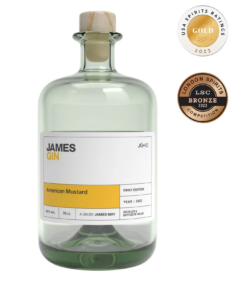Yellow Mustard Seed: Provides the mustard component of American Mustard.
Gherkin: The oft unacknowledged ally of mustard in enlivening any patty-based portable bread and meat delicacy. It’s invisible in the gin, so you don’t have to pick it out.
Juniper: Gin must contain juniper, or it isn’t gin. In fact, the name ‘gin’ is a shortening of the Dutch word for juniper, ‘jenever’. Not to be confused with ‘Geneva’, which is both a place and a convention but not a drink.
Coriander Seed: Some people are genetically indisposed towards coriander and believe it tastes of soap. They’re just weirdos, so it’s in the gin.
Angelica Root: Angelica Root was also the name of a famous 1920s blues singer from the Mississippi region. Here, it’s botanical.
Dried Tomato: Included not just for its flavour-enhancing properties but so we can have a debate over how to pronounce it.
Liquorice Root: Seventh son of Anjelica (see above), Liquorice was born blind and therefore became a blues guitarist. His band, The Allsorts, remain unknown beyond the Mississippi Delta.
Orange Peel: Since you asked, the color was named after the fruit in about 1512.
Cubeb Pepper: In the Chinese Tang dynasty, physicians administered cubeb pepper to restore appetite, cure “demon vapors”, darken the hair, and perfume the body. My gin will also do all of these things, possibly. Let us know how you get on and send photographs.
Rosemary: Not the mythical riveting factory worker of American WWII recruitment posters, just a herb.
Caraway Seed: Finland supplies about 28% of the world’s caraway seed. Also, many of the best racing drivers. This is because the word ‘car’ appears in both job descriptions.
Ginger: Although used in traditional medicine and as a dietary supplement, there is no good evidence that consuming ginger or its extracts has any beneficial effect on human health. But just in case it does, it’s in the gin.
Bay: This comes in several forms, such as James and San Francisco. Here, it is a leaf, which is easier to fit inside our still.
 Savoury ● Mustard ● Warm
Savoury ● Mustard ● Warm